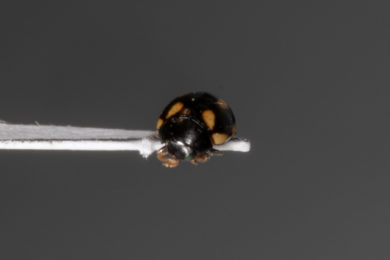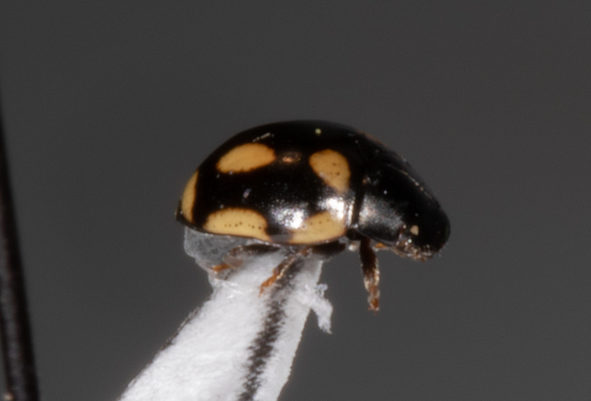New Lady Beetle Discovered in Vermont
On July 10, Kent McFarland and Nathaniel Sharp were sweep netting their way around Underhill, Vermont with a group of excited BioBlitzers. As they walked and chatted with the group, Kent said, “You just never know when you are going to find something cool. New species are discovered all the time.”
Kent’s words turned out to be prophetic for that very day. As they were all walking back towards the cars, Nathaniel saw something and swung his net. When he looked inside, he saw a small, black beetle with elongated spots. “I walked over to Kent and asked if he knew what species this was,” said Nathaniel. “Kent responded that he was not sure, so he took the beetle home to identify it.”
“Yeah as soon as I saw the thing I just had this feeling that this lady beetle was something special and knew that I had to take it back with me,” said Kent. After hours pouring over a key, Kent had a tentative identification—Hyperaspis disconotata, the Disk-marked Lady Beetle. Putting the images of the small beetle into iNaturalist confirmed the identification and that a new species of lady beetle had just been recorded in Vermont for the first time.
The Disk-marked Lady Beetle is native to North America and is relatively rare—there have only been a handful of records throughout history. This species can be found from the upper midwestern states such as Minnesota to the New England coast, then north into Canada. There is some indication that the Disk-marked Lady Beetle primarily utilizes arboreal (forest) ecosystems. Other than that, little else is known about this species.
Other species in the Hyperaspis genus, such as Hyperaspis binotata, are typically arboreal and are voracious predators of scale insects. Species within the Hyperaspis genus seem to be encountered most frequently between late spring to mid summer. It is possible that the Disk-marked Lady Beetle’s life history is similar to that of others in the Hyperaspis genus. This cannot be determined without more data, and you can help! Photograph any lady beetle you see and upload your photos to iNaturalist, where they will be included in the Vermont Lady Beetle Atlas on iNaturalist. You may just find a new species too.








